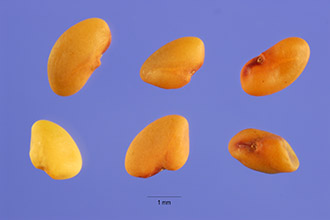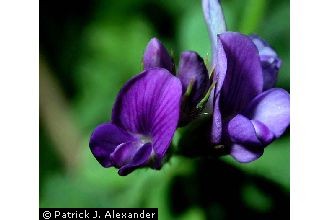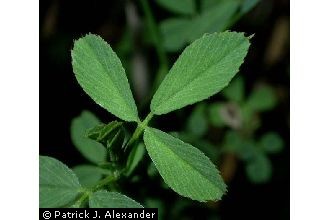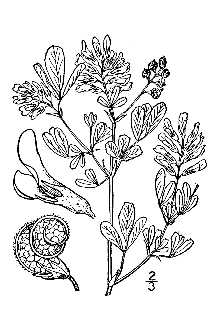Alfalfa
Scientific Name: Medicago sativa L.

| General Information | |
|---|---|
| Usda Symbol | MESA |
| Group | Dicot |
| Life Cycle | AnnualPerennial, |
| Growth Habits | Forb/herb |
| Native Locations | MESA |
Plant Guide
Use a soil moisture meter to monitor the soil moisture where Alfalfa is planted.
Fact Sheet
Uses
Crops: Alfalfa is harvested as hay which is processed or fed directly to livestock, or for seed production, It is also used in pellets as forage supplements, Livestock: This plant is grown in combination with grasses in improved pastures, Use soil moisture sensors to measure the soil moisture of Alfalfa., It is grazed by all types of domestic livestock, Caution should be taken when using alfalfa for grazing due to its high bloat hazard, Wildlife: Alfalfa is an excellent food for antelope, deer, elk, Canada goose, and sage and sharp tail grouse, It is fair food for sandhill crane, mallard, Hungarian partridge, and pheasant, In addition to providing high quality hay, grazing, and wildlife forage and protection, alfalfa is an important source of leaf meal used for fortifying baby food and other special diet foods prepared for human use, Large quantities of dehydrated alfalfa are also used in manufacturing concentrated feeds for poultry and livestock,
Status
Please consult the PLANTS Web site and your State Department of Natural Resources for this plant’s current status (e.g. threatened or endangered species, state noxious status, and wetland indicator values).
Weediness
This plant may become weedy or invasive in some regions or habitats and may displace desirable vegetation if not properly managed. Please consult with your local NRCS Field Office, Cooperative Extension Service office, or state natural resource or agriculture department regarding its status and use. Weed information is also available from the PLANTS Web site at plants.usda.gov.
Description
Medicago sativa L., alfalfa, is a long-lived perennial 1egume. Flowers vary in color from purple to yellow and are borne in loose clusters. Pods of alfalfa range from the sickle type to those that are twisted into spirals. Each pod contains several small kidney-shaped seeds. Alfalfa’s stems are erect and grow from a woody crown to about 2 to 3 feet tall. New growth occurs from buds in the crown. The plant has a tap root which may penetrate deep into the soil. Leaves are alternately arranged on the stem and are normally trifoliate. USDA NRCS National Plant Materials Center Beltsville, MD
Adaptation and Distribution
Distribution
Distribution
Alfalfa grows best on deep, well-drained, friable soils. Lands subject to frequent overflows or high water tables are unfavorable for alfalfa. The pH of the soil should be 6.5 or above. Alfalfa is distributed throughout the entire United States. For a current distribution map, please consult the Plant Profile page for this species on the PLANTS Website.
Establishment
A seedbed must be smooth, firm, free of weeds and trash, and contain adequate moisture for germination and emergence. Land grading must be sufficient to ensure good surface draining. Alfalfa should not be seeded as a first crop on newly leveled land where fill may settle and cause poor surface drainage. Five pounds of scarified, properly inoculated pure live seed (PLS) per acre evenly drilled ¼-inch deep on adapted, properly prepared sites will produce adequate stands. A combination drill and packer is desirable. Cultipacking soil before and after seeding is helpful to establishing a stand. Seeding depths should be no greater than ¼ inch on finer textured soils and no greater than ½ inch on sandy soils Spring seedings can be made 30 days before the average date of last killing frost. Other dates of seeding may be made during the late summer.
Management
In general, graze or cut for hay when alfalfa is in early bloom. Graze or cut to about a 2-inch height. Successive grazings and cuttings for hay should occur at ¼ bloom stage or after a 5 to 6 week recovery period. Alfalfa can best withstand grazing if rotated frequently or grazed in small strips. The last cutting of alfalfa should be made 3 to 4 weeks before the first killing frost date. Alfalfa may cause livestock to bloat. Care should be used in managing such grazing to reduce the possibility of this hazard.
Pests and Potential Problems
Alfalfa is susceptible to the spotted or pea aphid, alfalfa weevil, stem nematode, bacterial wilt, snout beetle, and several leaf spots. Cultivars, Improved, and Selected Materials (and area of origin) Alfalfa is the oldest crop grown for forage and there are many cultivars available on the open market. More than 440 publicly and privately developed cultivars were approved for certified seed production in the U.S. between 1962 and 1992. For a specific state or region of the U.S., use cultivars that are adapted and have been tested for local performance. Cultivars are readily available from commercial seed vendors.
Plant Traits
Growth Requirements
| CaCO3 Tolerance | Low |
|---|---|
| Frost Free Days, Minimum | 90 |
| Frost Free Days, Minimum | 100 |
| Fire Tolerance | High |
| Fire Tolerance | High |
| Fertility Requirement | Medium |
| Fertility Requirement | High |
| Drought Tolerance | High |
| Drought Tolerance | High |
| Cold Stratification Required | No |
| Cold Stratification Required | No |
| Temperature, Minimum (°F) | -43 |
| CaCO3 Tolerance | High |
| Anaerobic Tolerance | None |
| Anaerobic Tolerance | None |
| Adapted to Medium Textured Soils | Yes |
| Adapted to Medium Textured Soils | Yes |
| Adapted to Fine Textured Soils | Yes |
| Adapted to Fine Textured Soils | No |
| Adapted to Coarse Textured Soils | No |
| Adapted to Coarse Textured Soils | No |
| Hedge Tolerance | None |
| Temperature, Minimum (°F) | -33 |
| Shade Tolerance | Intolerant |
| Shade Tolerance | Intolerant |
| Salinity Tolerance | Medium |
| Salinity Tolerance | Medium |
| Root Depth, Minimum (inches) | 24 |
| Root Depth, Minimum (inches) | 24 |
| Precipitation, Minimum | 16 |
| Precipitation, Minimum | 12 |
| Precipitation, Maximum | 65 |
| Precipitation, Maximum | 30 |
| pH, Minimum | 6.2 |
| pH, Minimum | 6.0 |
| pH, Maximum | 8.5 |
| pH, Maximum | 7.2 |
| Moisture Use | Medium |
| Moisture Use | High |
| Hedge Tolerance | None |
Morphology/Physiology
| Active Growth Period | Spring, Summer, Fall |
|---|---|
| Toxicity | None |
| Toxicity | None |
| Shape and Orientation | Erect |
| Shape and Orientation | Erect |
| Resprout Ability | No |
| Fall Conspicuous | Yes |
| Foliage Porosity Winter | Porous |
| Foliage Porosity Summer | Moderate |
| Foliage Porosity Summer | Moderate |
| Foliage Color | Green |
| Foliage Color | Green |
| Flower Conspicuous | Yes |
| Flower Conspicuous | No |
| Flower Color | Purple |
| Flower Color | Purple |
| Fire Resistant | Yes |
| Fire Resistant | No |
| Nitrogen Fixation | High |
| Fall Conspicuous | No |
| Coppice Potential | No |
| Coppice Potential | No |
| C:N Ratio | Low |
| C:N Ratio | Low |
| Bloat | Medium |
| Bloat | High |
| After Harvest Regrowth Rate | Rapid |
| After Harvest Regrowth Rate | Moderate |
| Active Growth Period | Spring, Summer, Fall |
| Resprout Ability | No |
| Foliage Texture | Fine |
| Nitrogen Fixation | High |
| Low Growing Grass | No |
| Low Growing Grass | No |
| Lifespan | Long |
| Lifespan | Long |
| Leaf Retention | No |
| Leaf Retention | No |
| Known Allelopath | Yes |
| Known Allelopath | Yes |
| Height, Mature (feet) | 2.0 |
| Growth Rate | Rapid |
| Height, Mature (feet) | 1.6 |
| Foliage Porosity Winter | Porous |
| Foliage Texture | Fine |
| Fruit/Seed Color | Brown |
| Fruit/Seed Color | Brown |
| Fruit/Seed Conspicuous | No |
| Fruit/Seed Conspicuous | No |
| Growth Form | Single Crown |
| Growth Form | Single Crown |
| Growth Rate | Rapid |
Reproduction
| Propagated by Cuttings | No |
|---|---|
| Propagated by Seed | Yes |
| Propagated by Seed | Yes |
| Propagated by Sod | No |
| Propagated by Sod | No |
| Propagated by Sprigs | No |
| Propagated by Sprigs | No |
| Propagated by Tubers | No |
| Propagated by Tubers | No |
| Fruit/Seed Persistence | No |
| Seed per Pound | 226800 |
| Seed per Pound | 226800 |
| Seed Spread Rate | Slow |
| Seed Spread Rate | Slow |
| Seedling Vigor | High |
| Seedling Vigor | High |
| Small Grain | No |
| Small Grain | No |
| Vegetative Spread Rate | None |
| Vegetative Spread Rate | Slow |
| Propagated by Corm | No |
| Propagated by Cuttings | No |
| Bloom Period | Late Spring |
| Bloom Period | Spring |
| Commercial Availability | Routinely Available |
| Commercial Availability | Routinely Available |
| Fruit/Seed Abundance | High |
| Fruit/Seed Abundance | Medium |
| Fruit/Seed Period Begin | Summer |
| Fruit/Seed Period Begin | Summer |
| Fruit/Seed Period End | Summer |
| Fruit/Seed Persistence | No |
| Propagated by Bare Root | No |
| Propagated by Bare Root | No |
| Propagated by Bulb | No |
| Propagated by Bulb | No |
| Propagated by Container | No |
| Propagated by Container | No |
| Propagated by Corm | No |
| Fruit/Seed Period End | Summer |
Suitability/Use
| Palatable Browse Animal | High |
|---|---|
| Palatable Graze Animal | High |
| Palatable Graze Animal | High |
| Palatable Human | Yes |
| Palatable Human | Yes |
| Post Product | No |
| Post Product | No |
| Protein Potential | High |
| Protein Potential | High |
| Pulpwood Product | No |
| Pulpwood Product | No |
| Veneer Product | No |
| Veneer Product | No |
| Palatable Browse Animal | High |
| Nursery Stock Product | No |
| Nursery Stock Product | No |
| Naval Store Product | No |
| Naval Store Product | No |
| Lumber Product | No |
| Lumber Product | No |
| Fodder Product | Yes |
| Fodder Product | Yes |
| Christmas Tree Product | No |
| Christmas Tree Product | No |
| Berry/Nut/Seed Product | No |
| Berry/Nut/Seed Product | No |



